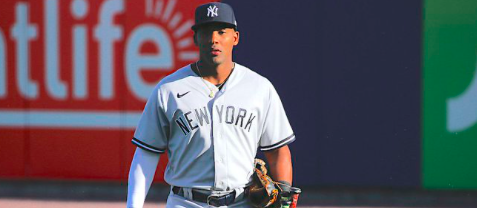A professional baseball player’s lasting appeal and historical impact is largely determined by his production on the field, but just as memorable for some fans is the manner in which a player conducts his business while compiling those stats. Baseball’s unique characters of the game endear and define themselves to fans in a manner that transcends numbers and dictates culture. Guys who have certain swag, distinctive style, or are so mechanically unorthodox that just watching them play is a thrilling and sometimes humorous spectacle.
These cats are baseball’s taste makers to a certain extent.
Remember Eddie Murray’s bushy stache, sideburns and Jheri curl fro? He looked like Jules in Pulp Fiction. The image of Joe Morgan’s elbow hitch at the plate is an instant reminder of Cincinnati’s Big Red Machine of the 1970’s. Ozzie Smith’s traditional pre-game back flip was classic.
Fernando Rodney shooting an arrow into the sky after each save.
Lee Smith’s scowl, Rollie Fingers’ waxed handle bar moustache, The Niekro Brothers knuckle ball game and Yogi Berra’s many quotes are automatic flashback-jerkers for me. How about the way Billy Martin went ballistic and kicked dirt on an ump’s foot in protest?
We can’t forget Mexican sensation Fernando Valenzuela looking up to the heavens before delivering balls to the plate with lethal results. Even with nine men working in unison, baseball is such an individual sport because each player does the same job in a different way.
Luis Tiant, “The Lost Son of Havana,” is one of those characters.
The Cuban hurler spent 19 years in MLB (1962-1982) and threw 3,486 1/3 innings for six teams (Cleveland Indians, Minnesota Twins, Boston Red Sox, NY Yankees, Pittsburgh Pirates and California Angels), produced four 20-game seasons and 229 wins. While Tiant’s career numbers are overall solid – borderline elite even – he’s more famous for his unique wind up, array of crazy pitches and use of multiple arms angles. Tiant had a high leg kick and often turned almost completely around, facing the center fielder, before delivering the ball to the plate. Most pitchers are taught to zero in on their target for the entire time when going through their motion and throwing a pitch.
Tiant didn’t look at his target at all at one point during his motion. As weird and funky as it appeared, it was very deceptive to batters who didn’t see the ball until it was being released from his glove, and it served Tiant well in his later years, helping to compensate for diminished velocity due to age.
His first six seasons (1964-1969) were spent with the Tribe and his best eight seasons were spent with the Red Sox (1971-1978), where he had three 20-win campaigns and dazzled Fenway fans with his mound mastery and unforgettable skills and survival tactics. He was gangster with setting hitters up, keeping them off balance and possessed an arsenal of pitches, which he’d exhaust if he had too.
Watching Cincinnati Reds pitcher extraordinaire Johnny Cueto box teams up like Solange did Jay in that elevator is like watching a throwback game of Tiant getting busy.
Not only does the 28-year old share Tiant’s highly unusual and funky windup—almost completely turning his back to the hitter.
Like Tiant did in that pitching rich '68 season, Cueto is quietly having one of the finest starts to a pitching season in MLB history. Just call him the Silent Assassin. The Dominican mound technician leads all qualifying pitchers in WHIP (0.71), innings pitched (72) ERA (1.43), and opponents batting average (.138) and is second in strikeouts with 76. He has thrown at least seven innings in each of his nine starts. In a era where pitchers make nine-figure contracts and are coddled and babied by strict pitch counts enforced by shook coaches and upper management, Cueto is old school.
Tiant averaged more than 200 innings pitched per season and is one of five pitchers to have pitched four or more consecutive shutouts in the 50-year expansion era, with Don Drysdale (six, 1968), Bullet Bob Gibson (five, 1968), Orel Hershiser (five, 1988) and Gaylord Perry (four, 1970) being the others.
A healthy Cueto will go deep in games, exceed the 100 pitch limit and even – baseball gods forbid – go a full nine innings as he did on Thursday in a complete game three-hit shutout against the San Diego Padres. Cueto leads MLB with three complete games and two shutouts in less than 10 starts. Adam Wainwright led MLB in complete games in 2013 with 5, but that was in 34 starts! Cueto, who won 19 games in 2012 and then was limited to 11 starts because of injury in 2013, has summoned his inner Tiant this season.
Since the advent of earned runs, only two other pitchers – Tiant (1.11 ERA and .147 opponents average) in the "Year of the Pitcher" and the white curly fro-rocking Don Sutton in ‘72 (1.27 ERA, .134 opponents average) – have an ERA lower than 1.50 and have held opponents batting average under .150 through their first nine starts.
A common thread in Tiant and Cueto’s pitching steez is that neither pitcher would be considered a prototypical power arm. Tiant struck out 200 or more batters just three times in two decades of hurling. He did whiff a sick 264 batters in '68, but being crafty is as much a part of his effectiveness as velocity.
Same with Johnny. Cueto’s season high is 170 K’s, but he can rip off double digit whiffs at the drop of a NYC dime. Both pitchers possess myriad ways to make a batter swing and miss and if a batter makes contact, it's usually not the type of rip he wanted. MLB Network’s Brian Kenny said, “If you like run prevention and missing bats. Cueto is your man.”
Fans who remember Tiant’s baseball exploits, surely get a kick out of watching a near spitting image of him in Cueto, baffle hitters with a unique, against-the-grain wind up that breaks the monotony of traditional pitching mechanics and brings gamesmanship and intrigue to MLB. The personal flair exhibited by both pitchers have earned them a permanent place in the sport's lore, as all-time style soldiers.



